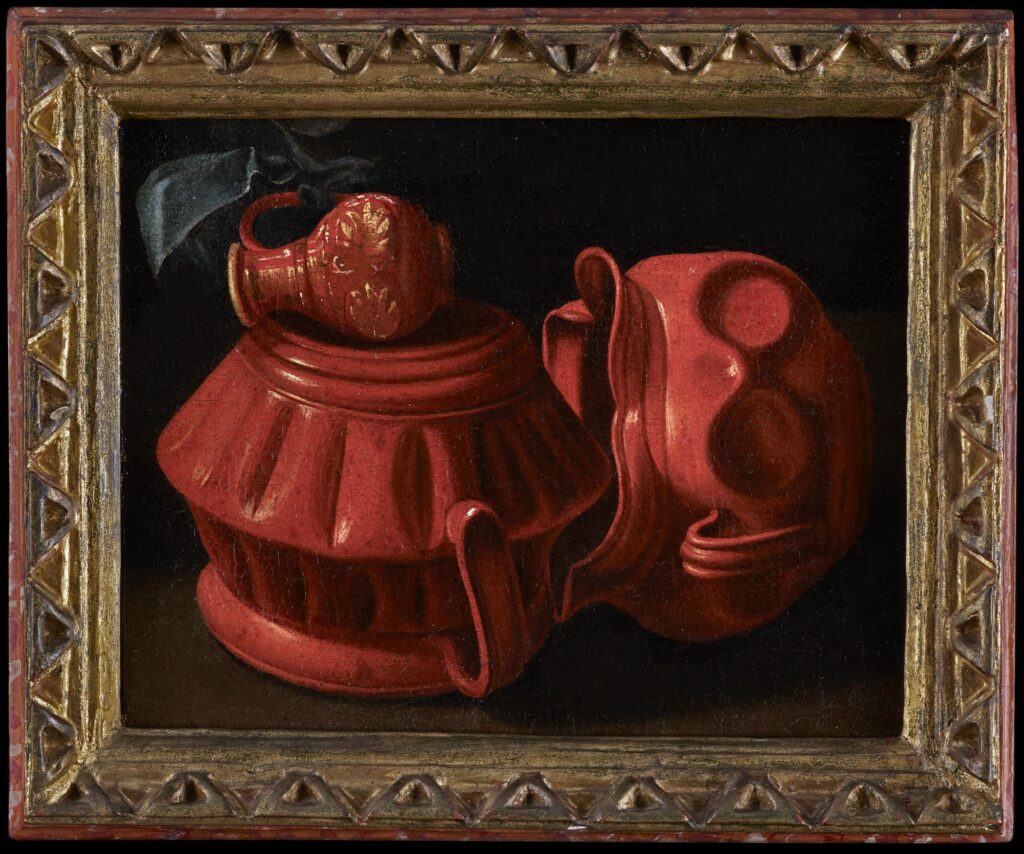Josefa Ayalla and Baltazar Gomes Figueira de Óbidos
Seville 1630 - 1684 Óbidos and Óbidos 1604 - 1674 Óbidos respectively
A Still Life with Terracotta Púcaros

Medium:
Oil on Canvas
Category:
Dimensions:
24.6(h) x 30.4(w) cms
Framed Dimensions:
31(h) x 38(w) cms
Essay:
Josepha de Óbidos (born Josepha de Ayalla Figueira) was born in Seville and raised by her father, the Portugese painter Baltazar Gomes Figueira, originally from Óbidos. Her mother, Catarina de Ayalla y Cabrera, was a native Andalusian. Baltazar had moved to Seville in the 1620s to further his painting career and had met Catarina there. When Josepha was four the family returned to Óbidos, a town 50 miles north of Lisbon.
In 1644 Josepha was in the Augustinian Convent of Santa Ana in Coimbra while her father worked on the altarpiece in the church of Nossa Senhora de Graça in Santa Cruz nearby. Whilst staying in the Convent, Josepha's first artistic forays were produced - engravings of St. Catherine and St. Peter. The facial characteristics of her figures show the influence of Francisco Zurbaran in their soft and rounded features (family inventories reveal that her father owned a number of paintings by him).
Shortly before 1653 the family returned to Óbidos from Coimbra. This was a successful period for both Josepha and her father who received numerous commissions for altarpieces in churches and convents.
As well as religious subjects Josepha's oeuvre also comprises portraits as well as highly accomplished still lifes which make up the bulk of her output. These demonstrate a particular mastery of hers and are very reminiscent of Sevillian bodegones, presumably influenced by her father's artistic training. These were also not without significant religious imagery. Her renown spread and she became well regarded internationally, held in some awe as a skilled female artist.
-
This remarkable and rare bodegón still life was painted by the greatest female painter of the Portuguese baroque. Josefa Ayalla de Óbidos has represented two large red pots atop a black tablecloth, their bulbous forms taking up almost the entire canvas space. The scalloped pitchers undulate as though they were still soft unfired clay. These are traditional terracotta púcaros from southern Portugal. Balanced over the lip of one is a small clay garrafa and around this is tied a ribbon. The ribbon is typical of Óbidos and features in several still lifes by her where they are decoratively tied around ceramics.
Óbidos's naturalism surpassed that of her father and rivalled her Spanish contemporaries like Francisco de Zurbarán. Also like them subtle iconographies run through her still lifes. An identical depiction attributed to Óbidos of the clay pots in the present painting is in the Palácio Nacional da Ajuda, Lisbon (inventory no.: PNA568 / PNA 66698). This larger version includes a silver salver of sweet pastries and a peach to the left of the composition. This is perhaps a reference to Lent when sweet things would be eaten, or perhaps to the Eucharist with the pots representing the wine.
Vitor Serrão has confirmed the attribution to Josefa de Ayalla, while Joaquim Oliveira Caetano of the Museu Nacional de Arte Antiga leans more towards a collaborative attribution.
In her PhD thesis Joana Filipa Rocha Gonçalves dates this work to c.1660.
Provenance:
Collection of the Nogueira Ferrão Vieira Family;
By descent to Maria João de Nogueira Ferrão Vieira Craigie (b. 1945), Lisbon.
Literature:
'Josefa de Óbidos and the Baroque Era', exh. cat., Lisbon, 1991, no. 21, p. 134, (illus.)
V. Serrão, 'Josefa de Óbidos: and the Baroque Era', Lisbon, 1993, p. 134.
'Josefa d’Óbidos and the Invention of the Portuguese Baroque', exh. cat., Lisbon, 2015, no. 76, p. 151 (illus.)
J. Gonçalves, 'Everyday Objects in the Painting of Josepha d’Ayalla - Imaginary or Archaeological Reality?', PhD thesis, Universidade Nova de Lisboa, 2012, pp 71 - 72, cat. no. 5.
Exhibitions:
Lisbon, Palácio Nacional da Ajuda, 'Josefa de Óbidos and the Baroque Era', 1991, no. 21.
Lisbon, The Museu Nacional de Arte Antiga, 'Josefa d’Óbidos and the Invention of the Portuguese Baroque', 2015, no. 76.